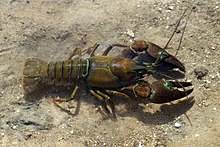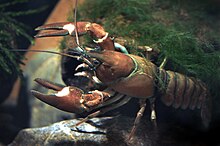|
Signal crayfish
The signal crayfish (Pacifastacus leniusculus) is a species of crayfish indigenous to North America. Introduced to Europe in the 1960s to supplement the North European Astacus astacus fisheries, which were being damaged by crayfish plague, it was subsequently discovered that the signal was itself a carrier of that disease. Consequently, the signal crayfish is now considered an invasive species across Europe, Japan, and California, having displaced the native species in these regions. Description and ecology Members of this species are typically 6–9 cm (2.4–3.5 in) long, although sizes up to 16–20 cm (6.3–7.9 in) are possible.[3] A distinctive white to pale blue-green patch is present near the claw hinge,[4] reminiscent of the white flags that signalmen used for directing trains—hence the species' common name. The lifecycle of the signal crayfish is typical for the family Astacidae. The mating season occurs in the autumn, during which time the female produces around 200 to 400 eggs. These are then carried under the female's tail until they are ready to hatch in the following spring.[3] Upon hatching, the juveniles undergo three stages of development, passing through (two moults), before they are able to leave their mother. Sexual maturity is reached after two to three years, and the lifespan can extend up to 20 years.[3] The signal crayfish is an omnivore, with a diet primarily consisting of detritus.[5] Adults can adapt to a broad range of salinity,[6][7]: 71 substrate types and the presence of aquatic vegetation.[6] Native rangeThe signal crayfish is endemic to North America west of the Rocky Mountains, including the Canadian province of British Columbia, and the U.S. states of Washington, Oregon, and Idaho.[8] It was introduced to California in 1912 into the San Lorenzo River watershed and from there rapidly spread throughout the state.[9] The only native crayfish remaining in California (aside from Pacifastacus leniusculus klamathensis, a subspecies of signal crayfish believed to be native to the Klamath River in Northern California) is the Shasta crayfish, of Shasta County, California (Pacifastacus fortis), where efforts are being made to create a barrier to signal crayfish invasion.[10] Within North America, it has also been introduced to Nevada, and the populations in Utah may be the result of introductions.[8] It has also been found in Alaska, specifically Kodiak Island, in the Buskin River and Buskin Lake. It is listed as a species of least concern on the IUCN Red List.[1] Introduction into Europe From 1907, crayfish plague, an infectious disease caused by the water mould Aphanomyces astaci, damaged stocks of the native European crayfish Astacus astacus. Since the signal crayfish occupied a similar ecological niche in its native range, it was imported in the 1960s to Sweden and Finland to allow recreational and commercial crayfish capture.[3] At the time, the signal crayfish was not recognized as a carrier of the crayfish plague.[3] All American species carry the infection, but it is only lethal to individuals that are already stressed; to European species, the infection is rapidly fatal.[11] The signal crayfish is now the most widespread alien crayfish in Europe, occurring in 25 countries, from Finland to Great Britain and from Spain to Greece.[3][12] It was first introduced to Great Britain in 1976,[13][14] and is now widespread across the British mainland as far north as the Moray Firth. It has also been observed on the Isle of Man, but not in Ireland,[11] the last European country to have no alien crayfish. In both Sweden and Finland, where crayfish are eaten, the catch of signal crayfish exceeds that of A. astacus (European/noble crayfish). The former is sold at roughly half the price compared to the latter.[15] In Europe, the signal crayfish has been included in the list of Invasive Alien Species of Union concern (the Union list) since 2016.[16] This implies that this species cannot be imported, bred, transported, commercialized, or intentionally released into the environment in the whole of the European Union.[17] The signal crayfish is often considered a nuisance species amongst anglers in Europe.[18] Multiple studies have been published to identify effective mitigation strategies for the detrimental impact of the settlement — and subsequent overpopulation — of invasive signal crayfish in Europe. This includes studies regarding effective upstream barriers against signal crayfish that do not adversely affect fish migration,[19][20] as well as other, aggressive but more efficient approaches which may cause further harm to existing ecosystems, such as eradication (by means of drainage or destruction of waterways, and biocides) and suppression (by means of extensive trapping, electrocution of waterways, and introduction of predatory fish), with eradication being most successful.[20] References
External linksWikimedia Commons has media related to Pacifastacus leniusculus.
|
||||||||||||||||||||||||||||||||

